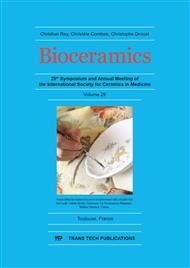[1]
H. Aoki, Medical Applications of Hydroxyapatite, Ishiyaku Euro America, Tokyo, 1994, p.174.
Google Scholar
[2]
S. Kannan, A. Rebelo, J.M.F. Ferreira, Novel synthesis and structural characterization of fluorine and chlorine co-substituted hydroxyapatites, J. Inorg. Biochem. 100 (2006) 1692–1697.
DOI: 10.1016/j.jinorgbio.2006.06.005
Google Scholar
[3]
G.W. Chinthaka Silva, L. Ma, O. Hemmers, D. Lindle, Micro-structural characterization of precipitation-synthesized fluorapatite nano-material by transmission electron microscopy using different sample preparation techniques, Micron 39 (2008).
DOI: 10.1016/j.micron.2007.09.004
Google Scholar
[4]
S. R. Kim, J. H. Lee, Y. T. Kim, D. H. Riu, S. J. Jung, Y. J. Lee, S. C. Chung, Y. H. Kim, Synthesis of Si, Mg substituted hydroxyapatites and their sintering behaviors, Biomaterials 24 (2003) 1389-1398.
DOI: 10.1016/s0142-9612(02)00523-9
Google Scholar
[5]
X. L. Tang, X. F. Xiao, R. F. Liu, Structural characterization of silicon-substituted hydroxyapatite synthesized by a hydrothermal method, Mater. Lett. 59 (2005) 3841-3846.
DOI: 10.1016/j.matlet.2005.06.060
Google Scholar
[6]
R. Itoh, Y. Suyama, Sodium excretion in relation to calcium and hydroxyproline excretion in a healthy Japanese population, Am. J. Clin. Nutr. 63 (1996) 735–740.
DOI: 10.1093/ajcn/63.5.735
Google Scholar
[7]
F. Ginty, A. Flynn, K.D. Cashman, The effect of dietary sodium intake on biochemical markers of bone metabolism in young women, Br. J. Nutr. 79 (1998) 343–350.
DOI: 10.1079/bjn19980058
Google Scholar
[8]
M. Šupová, Substituted hydroxyapatites for biomedical applications: A review, Ceram. Int. 41 (2015) 9203- 9231.
DOI: 10.1016/j.ceramint.2015.03.316
Google Scholar
[9]
E. F. Hafed, M. S. Jean, B. S. Abdelhamid, J. Mohamed, Sodium and carbonate distribution in substituted calcium hydroxyapatite, Solid State Sci. 2 (2000) 577-586.
Google Scholar
[10]
S. M. Barinov, I. V. Fadeeva, D. Ferro, J. V. Rau, S. N. Cesaro, V. S. Komlev, A. S. Fomin, Stabilization of carbonate hydroxyapatite by isomorphic substitutions of sodium for calcium, Russ. J. Inorg. Chem. 53 (2008) 164-168.
DOI: 10.1134/s0036023608020022
Google Scholar
[11]
J. Li, Y. Li, L. Zhang, Y. Zuo, Composition of calcium deficient Na-containing carbonate hydroxyapatite modeified with Cu(II) and Zn (II) ions, Appl. Surf. Sci. 254 (2008) 2844-2850.
DOI: 10.1016/j.apsusc.2007.10.030
Google Scholar
[12]
N. Y. Mostafa, H. M. Hassan, O. H. Abd Elkader, Preparation and characterization of Na+, SiO44- and CO32- co-substituted hydroxyapatite, J. Am. Ceram. Soc. 94 (2011) 1584-1590.
DOI: 10.1111/j.1551-2916.2010.04282.x
Google Scholar
[13]
G. L. Messing, S. -C. Zhang, G. V. Jayanthi, Ceramic powder synthesis by spray pyrolysis, J. Am. Ceram. Soc. 76 (1993) 2707–2726.
DOI: 10.1111/j.1151-2916.1993.tb04007.x
Google Scholar
[14]
M. Aizawa, K. Itatani, I. Okada, Synthesis of various apatites and porous coating of biocompatible calcium-phosphate films via spray-pyrolysis technique, Phosphorus Res. Bull. 20 (2006) 61-78.
DOI: 10.3363/prb.20.61
Google Scholar
[15]
M. Aizawa, T. Hanazawa, K. Itatani, F. S. Howell, A. Kishioka, Characterization of hydroxyapatite powders prepared by ultrasonic spray-pyrolysis technique, J. Mater. Sci. 34 (1999) 2865-2873.
DOI: 10.3363/prb1992.6.0_217
Google Scholar
[16]
T. Kokubo, H. Kushitani, S. Sakka, T. Kitsugi, T. Yamamuro, Solutions able to reproduce in vivo surface-structure changes in bioactive glass-ceramics A-W, J. Biomed. Mater. Res. 24 (1990) 721–734.
DOI: 10.1002/jbm.820240607
Google Scholar
[17]
J. S. Cho, S. -H. Um, D. S. Yoo, Y. -C. Chung, S. H. Chung, J. -C. Lee, S. -H. Rhee, Enhanced osteoconductivity of sodium-substituted hydroxyapatite by system insability, J. Biomed. Mater. Res. B Appl. Biomater. 102 (2014) 1046-1062.
DOI: 10.1002/jbm.b.33087
Google Scholar
[18]
H. El Feki, A. Ben Salah, A. Daoud, A. Lamure, C. Lacabanne, Studies by thermally stimulated current (TSC) of hydroxyl and fluoro-carbonated apatites containing sodium ions, J. Phys. Condens. Mater. 12 (2000) 8331– 8343.
DOI: 10.1088/0953-8984/12/38/309
Google Scholar
[19]
S. Kannan, J.M.G. Ventura, A.F. Lemos, A. Barba, J.M.F. Ferreira, Effect of sodium addition on the preparation of hydroxyapatites and biphasic ceramics, Ceram. Int. 34 (2008) 7–13.
DOI: 10.1016/j.ceramint.2006.07.007
Google Scholar
[20]
W. Suchanek, M. Yashima, M Kakihara, M. Yoshimura. Hydroxyapatite ceramics with selected sintering additives, Biomaterials 18 (1997) 923-933.
DOI: 10.1016/s0142-9612(97)00019-7
Google Scholar


